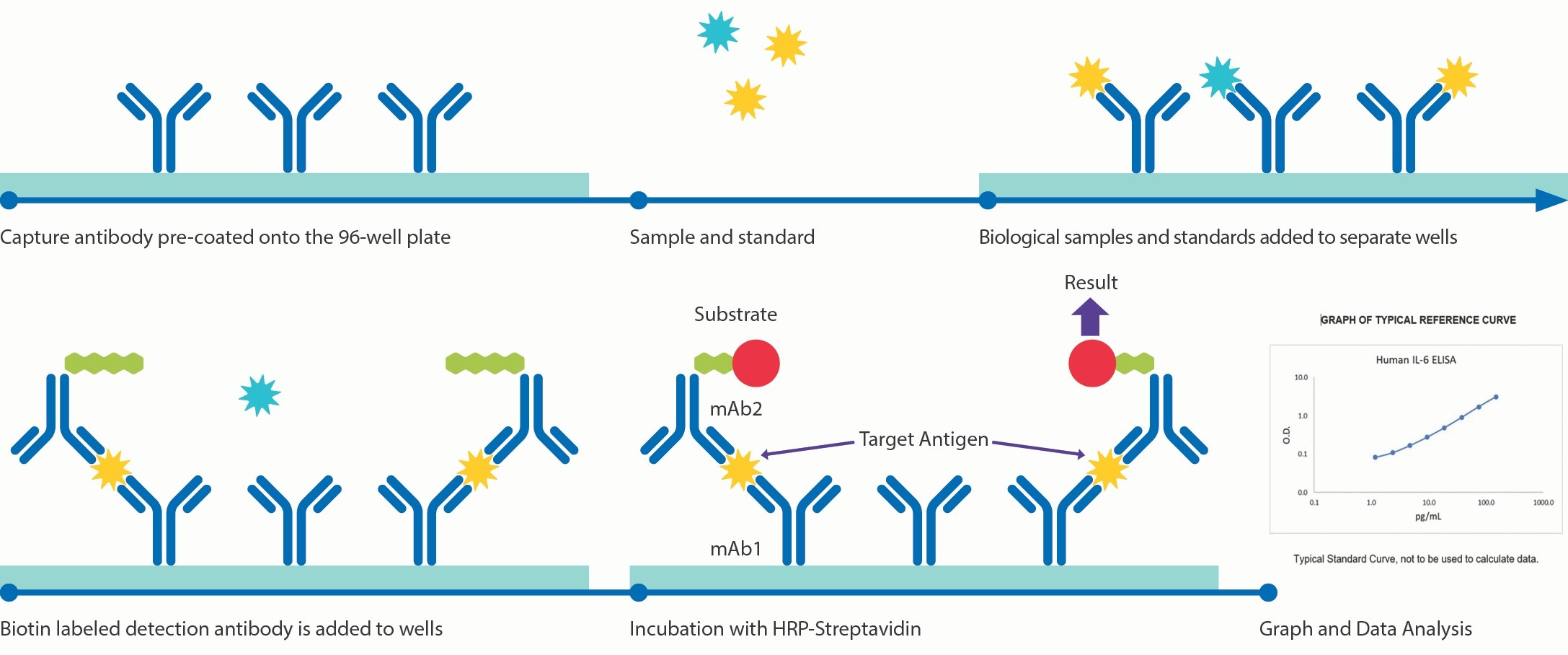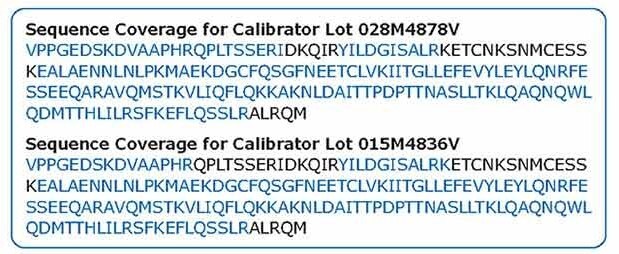Conferma® ELISAs: Sample Detection and Assay Consistency By Design
When you need strong sample detection and long-term assay consistency turn to Conferma® ELISAs. Our ELISAs are developed and manufactured in-house from critical reagent to finished assay with an intense focus on consistent performance from lot to lot.
Summary of the Conferma® ELISA Principles:
- Complete 96-well assays, including quality controls (Low, Medium, High)
- Critical reagents stringently evaluated physiochemically lot to lot
- Gold standards established to confirm reproducibility
- Endogenous sample bridging established as a lot release test

Figure 1.Conferma® ELISAs provide high sample detection and lot-to-lot consistency. (A.) The % sample detection (above limit of detection, or LOD) in normal and diseased serum samples using Conferma® ELISAs for the analytes TNF-α, IL-6, IL-8, and MCP-1. (B.) Example of finished kit testing of the TNF-α ELISA. Calibration curves from 3 lots were compared for mathematical similarity where a value of 1 is considered perfect parallelism. Lots 1, 2, and 3, are represented by the blue, yellow, and magenta lines respectively. Parallelism of Lot 2 vs. Lot 1 was 0.983 and Lot 3 vs. Lot 1 was 0.992.
Introduction To The Conferma® ELISA Method
Research Use Only (RUO) assays are used within a wide range of studies, from discovery to clinical trials. While the RUO tag places no regulatory burden on a manufacturer, documents such as the ICH M10 guidance1 indicate the rigor an end user will be required to implement depending on the nature of their studies. To address this spectrum of research it is necessary to produce an assay that can stand up to a high degree of verification, which is available off the shelf to all researchers. With this in mind, we undertake a detailed evaluation of our critical reagents and rigorous R&D testing, all while using stringent QC procedures. Read on to discover the details of each step of the Conferma® ELISA method.
How Conferma® ELISAs Work
Conferma® ELISAs follow a sandwich ELISA format. A sandwich ELISA is a common enzyme-linked immunosorbent assay (ELISA) procedure that measures the antigen level of a sample and compares it to the response from the known level of a similar target, usually serially diluted to become a standard curve. The antigen is “sandwiched” between two antibodies, the capture antibody and the detection antibody. These antibodies can be either polyclonal antibodies or, as with our Conferma® ELISAs, monoclonal antibodies (mAbs). Sandwich ELISAs are considered to be one of the more sensitive and specific types of ELISAs for antibody detection to analyze biomarkers as two unique epitopes are required to determine that the correct protein has been identified. Figure 2 shows a representation of how these Conferma® assays work.

Figure 2.How Conferma® ELISAs work. Conferma® ELISAs use the sandwich ELISA method to detect antibodies for measuring biomarkers. This includes pre-coating the capture antibody on a 96-well plate, adding the sample containing the target, and including the standard. Adding the biotin-labeled detection antibodies to the wells and incubating with horseradish peroxidase (HRP)-streptavidin completes the sandwich and provides a signal to determine concentration.
Critical Reagent Verification
Conferma® critical reagents, the monoclonal antibodies and recombinant calibrator proteins (standard/QC), are produced in-house at our Centers of Excellence in California, U.S. and Israel. Extensive testing confirms the reagent’s similarity and performance. For instance, the calibrator proteins are very similar to the mature sequences published in UniProt, and the assay’s mAbs have a high affinity toward them.
We use the following physiochemical techniques to test Conferma® critical reagents:
- Mass Spectrometry (LC-MS/MS & RP-LC-UV-MS, Figure 3 and Table 1): Providing the sequence of a protein and determining its measured mass
- SPR (Surface Plasmon Resonance, Table 2): Confirms the high affinity (KD <0.5 nM) of each mAb to the standard
- AAA (Amino Acid Analysis): Gold standard for protein concentration

Figure 3.LC-MS/MS Analysis. Sequence coverage of two lots of IL-6 Conferma® ELISA calibrator material based on LC-MS analysis. The blue highlight shows the identified sequences of IL-6.
Assay Testing Principles & Techniques
Assay feasibility testing determines the operating parameters that an assay will be expected to perform to both in-house and in the hands of a scientist. Recommended tests are well documented1-4, for instance in the ICH M10 guidance,1 and we include many of them when testing Conferma® ELISAs (Table 3). A full list of testing can be found in each assay’s verification report. Example testing data is shown in Figure 4.

Figure 4.Example of Assay Testing Data. (A.) Sample parallelism example for the Conferma® MCP-1 ELISA. Five endogenous serum samples with high levels of target protein diluted and back-calculated to the original value. (B.) Sample recovery testing example for the Conferma® TNF-α ELISA. Five human serum samples spiked with three known amounts of recombinant protein. Recovery is expressed as a range and average value (e.g., TNF-α Serum = 85%-105%, Average = 95%).
Lot-to-Lot Consistency
ELISAs form a key part of a laboratory’s experimental strategy through both repeated one-off use and as part of ongoing longitudinal studies. In both cases knowing the assay is performing consistently over the long term is a key consideration. Conferma® ELISAs start with lot-to-lot critical reagent testing before manufacturing the kit, finished kit confirmation vs an internal reference standard, and an endogenous sample bridge with data recorded in long-term trend charts (Table 4). Examples of data from this testing are shown in Figure 1B (standard curve comparison/parallelism) and Table 5 (sample lot-to-lot bridging).
Conferma® ELISA Products
Conferma® ELISAs are designed and tested to deliver strong sample detection and dynamic range, lot to lot. The methods and protocols used to achieve this are some of the most modern that are currently applied in our industry. The result is assays designed to deliver.
Each assay has two key documents, a verification report detailing the assay’s testing process and a lot-specific Certificate of Analysis that can be found on their respective product pages linked below. You can also find the protocols for each ELISA on these pages.
You can also watch this webinar to learn more about the details behind the Conferma® ELISA process.
For Research Use Only. Not For Use In Diagnostic Procedures.
References/Further Reading
To continue reading please sign in or create an account.
Don't Have An Account?